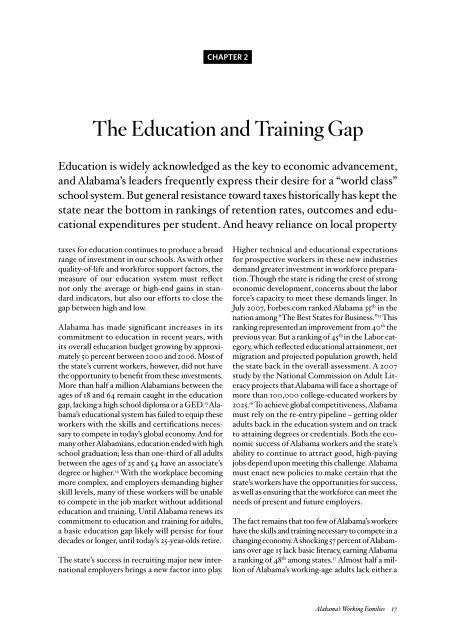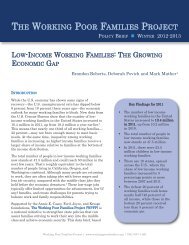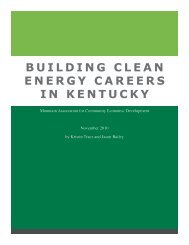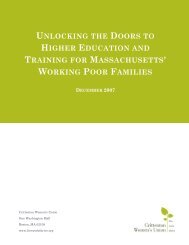alabama's working families and the broken promise of economic ...
alabama's working families and the broken promise of economic ...
alabama's working families and the broken promise of economic ...
- No tags were found...
You also want an ePaper? Increase the reach of your titles
YUMPU automatically turns print PDFs into web optimized ePapers that Google loves.
CHAPTER 2The Education <strong>and</strong> Training GapEducation is widely acknowledged as <strong>the</strong> key to <strong>economic</strong> advancement,<strong>and</strong> Alabama’s leaders frequently express <strong>the</strong>ir desire for a “world class”school system. But general resistance toward taxes historically has kept <strong>the</strong>state near <strong>the</strong> bottom in rankings <strong>of</strong> retention rates, outcomes <strong>and</strong> educationalexpenditures per student. And heavy reliance on local propertytaxes for education continues to produce a broadrange <strong>of</strong> investment in our schools. As with o<strong>the</strong>rquality-<strong>of</strong>-life <strong>and</strong> workforce support factors, <strong>the</strong>measure <strong>of</strong> our education system must reflectnot only <strong>the</strong> average or high-end gains in st<strong>and</strong>ardindicators, but also our efforts to close <strong>the</strong>gap between high <strong>and</strong> low.Alabama has made significant increases in itscommitment to education in recent years, withits overall education budget growing by approximately50 percent between 2000 <strong>and</strong> 2006. Most <strong>of</strong><strong>the</strong> state’s current workers, however, did not have<strong>the</strong> opportunity to benefit from <strong>the</strong>se investments.More than half a million Alabamians between <strong>the</strong>ages <strong>of</strong> 18 <strong>and</strong> 64 remain caught in <strong>the</strong> educationgap, lacking a high school diploma or a GED. 13 Alabama’seducational system has failed to equip <strong>the</strong>seworkers with <strong>the</strong> skills <strong>and</strong> certifications necessaryto compete in today’s global economy. And formany o<strong>the</strong>r Alabamians, education ended with highschool graduation; less than one-third <strong>of</strong> all adultsbetween <strong>the</strong> ages <strong>of</strong> 25 <strong>and</strong> 54 have an associate’sdegree or higher. 14 With <strong>the</strong> workplace becomingmore complex, <strong>and</strong> employers dem<strong>and</strong>ing higherskill levels, many <strong>of</strong> <strong>the</strong>se workers will be unableto compete in <strong>the</strong> job market without additionaleducation <strong>and</strong> training. Until Alabama renews itscommitment to education <strong>and</strong> training for adults,a basic education gap likely will persist for fourdecades or longer, until today’s 25-year-olds retire.The state’s success in recruiting major new internationalemployers brings a new factor into play.Higher technical <strong>and</strong> educational expectationsfor prospective workers in <strong>the</strong>se new industriesdem<strong>and</strong> greater investment in workforce preparation.Though <strong>the</strong> state is riding <strong>the</strong> crest <strong>of</strong> strong<strong>economic</strong> development, concerns about <strong>the</strong> laborforce’s capacity to meet <strong>the</strong>se dem<strong>and</strong>s linger. InJuly 2007, Forbes.com ranked Alabama 35 th in <strong>the</strong>nation among “The Best States for Business.” 15 Thisranking represented an improvement from 40 th <strong>the</strong>previous year. But a ranking <strong>of</strong> 45 th in <strong>the</strong> Labor category,which reflected educational attainment, netmigration <strong>and</strong> projected population growth, held<strong>the</strong> state back in <strong>the</strong> overall assessment. A 2007study by <strong>the</strong> National Commission on Adult Literacyprojects that Alabama will face a shortage <strong>of</strong>more than 100,000 college-educated workers by2025. 16 To achieve global competitiveness, Alabamamust rely on <strong>the</strong> re-entry pipeline – getting olderadults back in <strong>the</strong> education system <strong>and</strong> on trackto attaining degrees or credentials. Both <strong>the</strong> <strong>economic</strong>success <strong>of</strong> Alabama workers <strong>and</strong> <strong>the</strong> state’sability to continue to attract good, high-payingjobs depend upon meeting this challenge. Alabamamust enact new policies to make certain that <strong>the</strong>state’s workers have <strong>the</strong> opportunities for success,as well as ensuring that <strong>the</strong> workforce can meet <strong>the</strong>needs <strong>of</strong> present <strong>and</strong> future employers.The fact remains that too few <strong>of</strong> Alabama’s workershave <strong>the</strong> skills <strong>and</strong> training necessary to compete in achanging economy. A shocking 57 percent <strong>of</strong> Alabamiansover age 15 lack basic literacy, earning Alabamaa ranking <strong>of</strong> 48 th among states. 17 Almost half a million<strong>of</strong> Alabama’s <strong>working</strong>-age adults lack ei<strong>the</strong>r aAlabama’s Working Families 17







